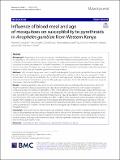| dc.contributor.author | Maxwell G Machani, Eric Ochomo, David Sang, Mariangela Bonizzoni, Guofa Zhou, Andrew K Githeko, Guiyun Yan, Yaw A Afrane | |
| dc.date.accessioned | 2020-11-30T08:54:34Z | |
| dc.date.available | 2020-11-30T08:54:34Z | |
| dc.date.issued | 2019 | |
| dc.identifier.uri | https://repository.maseno.ac.ke/handle/123456789/3083 | |
| dc.description.abstract | Background: Physiological characteristics (age and blood feeding status) of malaria vectors can influence their
susceptibility to the current vector control tools that target their feeding and resting behaviour. To ensure the sustainability
of the current and future vector control tools an understanding of how physiological characteristics may
contribute to insecticide tolerance in the field is fundamental for shaping resistance management strategies and
vector control tools. The aim of this study was to determine whether blood meal and mosquito age affect pyrethroid
tolerance in field-collected Anopheles gambiae from western Kenya.
Methods: Wild mosquito larvae were reared to adulthood alongside the pyrethroid-susceptible Kisumu strain. Adult
females from the two populations were monitored for deltamethrin resistance when they were young at 2–5 days
old and older 14–16 days old and whether fed or unfed for each age group. Metabolic assays were also performed to
determine the level of detoxification enzymes. Mosquito specimens were further identified to species level using the
polymerase chain reaction (PCR) method.
Results: Anopheles gambiae sensu stricto was the predominant species comprising 96% of specimens and 2.75%
Anopheles arabiensis. Bioassay results showed reduced pyrethroid induced mortality with younger mosquitoes
compared to older ones (mortality rates 83% vs. 98%), independently of their feeding status. Reduced mortality was
recorded with younger females of which were fed compared to their unfed counterparts of the same age with a mortality
rate of 35.5% vs. 83%. Older blood-fed females showed reduced susceptibility after exposure when compared
to unfed females of the same age (mortality rates 86% vs. 98%). For the Kisumu susceptible population, mortality was
straight 100% regardless of age and blood feeding status. Blood feeding status and mosquito age had an effect on
enzyme levels in both populations, with blood fed individuals showing higher enzyme elevations compared to their
unfed counterparts (P < 0.0001). The interaction between mosquito age and blood fed status had significant effect on
mosquito mortality.
Conclusion: The results showed that mosquito age and blood feeding status confers increased tolerance to insecticides
as blood feeding may be playing an important role in the toxicity of deltamethrin, allowing mosquitoes to rest
on insecticide-treated materials despite treatment. These may have implications for the sustained efficacy of indoor
residual spraying and insecticide-treated nets based control programmes that target indoor resting female mosquitoes
of various gonotrophic status. | en_US |
| dc.publisher | BioMed Central | en_US |
| dc.subject | Anopheles gambiae, Feeding status, Age, Pyrethroid resistance, Kenya | en_US |
| dc.title | Influence of blood meal and age of mosquitoes on susceptibility to pyrethroids in Anopheles gambiae from Western Kenya | en_US |
| dc.type | Article | en_US |

